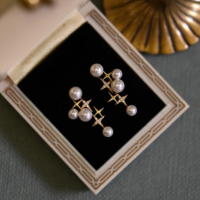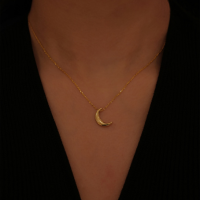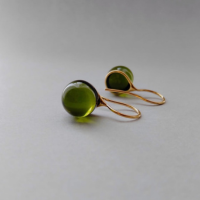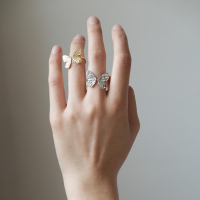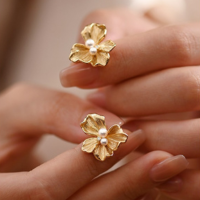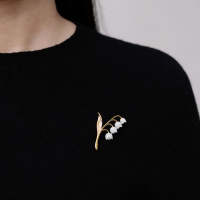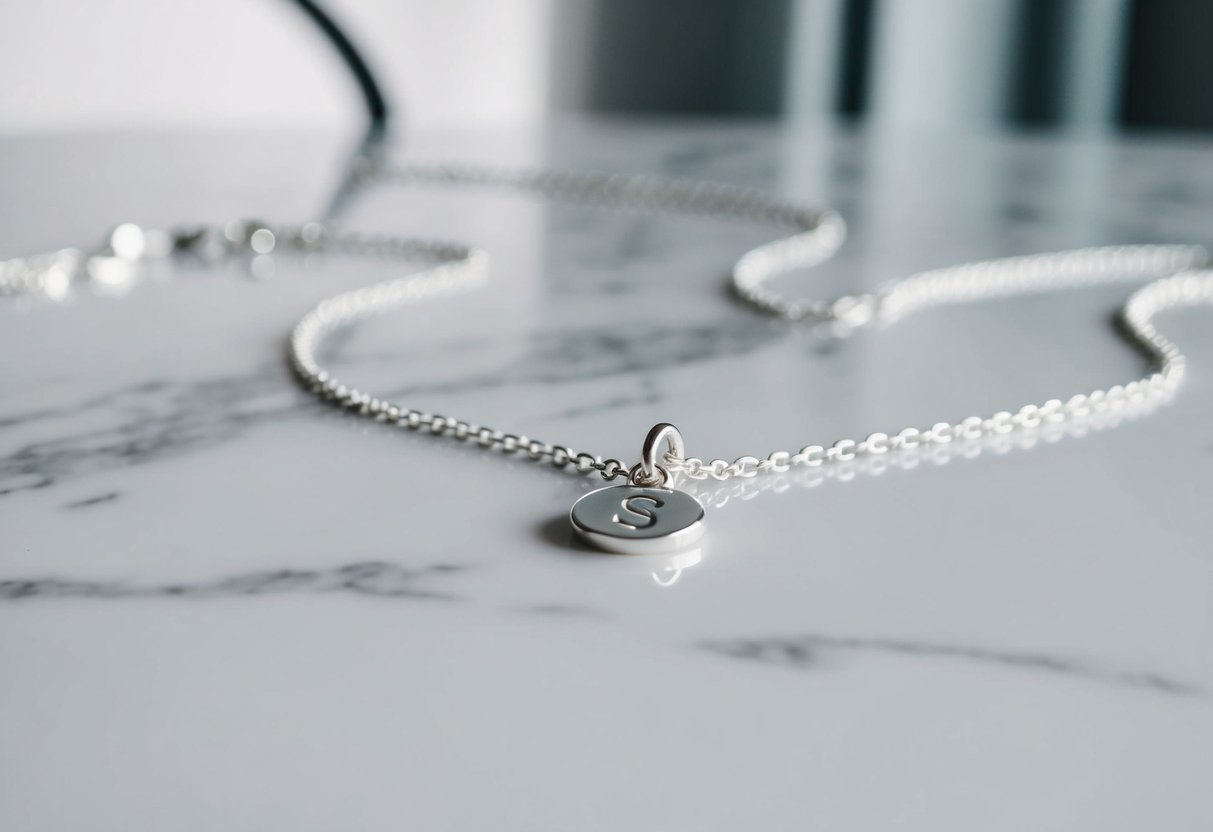
Mixing Metals and Materials: Innovative Ways to Personalize Your Jewelry
Check out our personalized jewelry collections! (kids drawing jewelry, coin jewelry, wire jewelry, fingerprint jewelry, handwriting jewelry, and more)
As jewelry enthusiasts, we are always looking for ways to express our unique style. Mixing metals and materials offers a fantastic opportunity to personalize our jewelry collections, allowing us to blend various elements into stunning combinations.
There's a certain charm in combining different metals such as gold, silver, and platinum with unconventional materials like leather or gemstones. These combinations not only add depth to our collections but also enhance our overall aesthetic appeal. We can experiment with textures and colors, making our jewelry truly one of a kind.
By understanding the techniques and trends in mixed media jewelry, we can make informed choices that align with our fashion preferences. For those who love to stay ahead of the curve, exploring current trends and designs can inspire us to craft or purchase pieces that are both innovative and timeless.
The Allure of Personalized Jewelry
We believe that jewelry is more than just an accessory. It's a form of self-expression, a way to carry memories and stories with us wherever we go. Personalized jewelry allows us to transform beautiful pieces into meaningful treasures. The allure lies in the ability to wear something uniquely ours.
Each piece is a reflection of personal taste and individuality. Custom engravings, choice of materials, and design preferences make each item one-of-a-kind. Whether it's a special date inscribed on a pendant or initials on a ring, these details create a connection between the wearer and the piece.
There's also the opportunity to incorporate symbolic elements, such as gemstones representing birth months or personal milestones. We have the chance to curate pieces that not only enhance our style but also carry personal significance. This makes gifting personalized jewelry a thoughtful gesture, conveying affection and consideration.
Below are a few ideas for customization:
- Engravings: Names, dates, or quotes.
- Gemstones: Birthstones or favorites.
- Textures: Mixing metals or finishes.
Personalized jewelry taps into our desire to feel unique. It offers us a canvas to display our stories, preferences, and connections. As we explore the world of jewelry, the potential to customize invites us to express who we are in creative and timeless ways.
Essential Concepts in Metal Mixing
When it comes to jewelry design, mixing metals can elevate the aesthetic and personalize our pieces. Combining metals like gold, silver, and rose gold opens up a world of possibilities.
Color Variations
The interaction between different metal hues can offer unique contrasts and aesthetic harmony. Gold's warm tones alongside the coolness of silver create a classic yet eye-catching look.
Finish Choices
We can explore finishes like matte, brushed, or polished to complement the mixed metals. A polished gold surface next to a brushed silver gives an intriguing contrast that draws attention.
Strength and Durability
Blending metals isn’t just about appearance. It's important to consider the durability of each metal. For example, pairing a softer metal like gold with a stronger one like platinum enhances longevity.
Metal Compatibility
We should ensure that the metals we choose wear well together. Avoid combining metals that react negatively, which might compromise the jewelry’s integrity over time.
Customization Options
Mixing metals offers vast customization opportunities. We can incorporate different textures, colors, and finishes to reflect personal style. This freedom makes our jewelry uniquely ours.
Care and Maintenance
Each metal requires specific care. We must clean and store them following individual guidelines to preserve their beauty. A consistent maintenance routine enhances longevity.
Blending metals in our jewelry allows exploration of textures and tones. By understanding these essential concepts, we create pieces that are both beautiful and durable.
Combining Metals for Aesthetic Appeal
Mixing metals in jewelry allows us to craft pieces with unique visual interest. By varying colors, textures, and contrasts, we can create stunning combinations that reflect personal style.
Color and Texture in Metal Combinations
Using a blend of colors and textures enhances jewelry's visual appeal. By pairing metals like gold, silver, and rose gold, we achieve vibrant contrasts. Textures add dimension, as matte finishes contrast with polished ones.
Imagine a bracelet with alternating smooth silver and hammered gold links. Each metal's unique feel and appearance offer a multi-dimensional look that captivates.
Contrast helps highlight individual elements, while textures provide a tactile experience. The right combination of color and texture elevates a piece from simple to extraordinary.
Creating Contrast with Different Metals
Contrast is a powerful tool in jewelry design. Combining metals like bright silver with deep, warm copper creates striking visual appeal. This approach makes individual elements stand out.
Consider jewelry with silver and blackened steel beads. The stark contrast draws attention and creates a bold statement. Variations in metal finish, such as brushed and polished, further enhance this effect.
Playing with different contrasts in a single piece lets us express personality and style. Mixing different shades and tones leads to uniquely captivating designs.
Harmonizing Metals for a Cohesive Look
Creating harmony involves balancing different metals to form a unified design. We choose metals with complementary hues to ensure they blend seamlessly.
A necklace combining yellow gold and platinum with a common motif, like hearts or leaves, showcases this harmony. Matching metal widths and similar textures help maintain a cohesive appearance.
Achieving harmony in metal combinations results in jewelry that feels intentional and thoughtfully designed. By considering proportions and unity, we craft pieces that look organically beautiful together without visual discord.
Integrating Alternative Materials
When we look at jewelry design, incorporating non-traditional materials offers a chance to create distinctive pieces. Mixing alternatives like gemstones, wood, leather, and modern materials can lead to both luxurious and unique results that stand out.
Incorporating Gemstones
Incorporating gemstones allows us to add color and sparkle in countless ways. Popular choices include diamonds, sapphires, and emeralds, each bringing their unique flair.
Gemstones aren’t just for aesthetics; they often carry personal significance or historical meaning. This adds layers of personal value to the pieces.
Pairing metals like gold or silver with gemstones can transform ordinary jewelry into a masterpiece. The contrast between the metal and the colored gems enhances the visual appeal and allows for more intricate designs.
Using Wood and Leather
Wood and leather introduce an earthy, natural touch to our jewelry. They can soften metal pieces and add a sense of warmth.
Woods, such as ebony or sandalwood, provide a rich, organic feel. Leather bands or accents offer flexibility in design, making pieces versatile and comfortable.
These materials work well with both traditional and contemporary styles. Combining wood or leather with metals can create a striking, balanced look. It’s a great way to explore texture and contrast.
Exploring High-Tech Materials
High-tech materials like titanium, carbon fiber, and ceramics open up exciting new avenues. These materials offer durability along with a modern aesthetic.
Titanium is lightweight yet incredibly strong, making it ideal for rings or bracelets that are both fashionable and practical. Carbon fiber showcases a sleek, modern look and pairs well with other metals.
Ceramic elements introduce a new palette of colors and finishes. By incorporating high-tech materials into jewelry, we push the boundaries of what’s possible, creating unique and innovative designs. They allow us to break away from traditional norms, leading to futuristic and cutting-edge styles.
Techniques in Innovative Jewelry Design
Exploring various techniques can transform simple elements into standout pieces. By focusing on layering, custom engraving, and texture, we open up numerous creative avenues for personalizing jewelry with distinct character and charm.
Layering and Stacking Strategies
Layering and stacking can bring depth and dimension to jewelry. We often mix metals, using both gold and silver, to create a vibrant and versatile look.
Different lengths and styles allow us to add a dynamic effect, whether that's by stacking rings or layering necklaces. Using varied textures or unique shapes adds further interest and uniqueness to each personalized piece.
Pairing minimalistic pieces with bold, statement jewelry can enhance visual appeal. Balance is key; we should aim for contrast without overwhelming the senses. A mix of understated and eye-catching pieces ensures an appealing aesthetic.
Custom Engraving Tips
Custom engraving is perfect for adding a personal touch. We can include initials, dates, or meaningful symbols to make the jewelry truly one of a kind. Fonts play a significant role; choosing between classic and modern fonts can set the tone for the piece.
Inscriptions on the interior or exterior of rings or bracelets can enhance their sentimental value. Opt for quality engraving techniques to ensure lasting clarity and precision.
Additionally, considering the placement relative to other design elements is important. By ensuring our engravings complement rather than overshadow other design features, we create cohesive and meaningful designs.
The Role of Texture and Finish
Texture and finish contribute to a piece's visual and tactile appeal. We might incorporate hammered, brushed, or polished finishes to add depth. Each finish offers a different vibe, from rustic to refined.
Textures can be mixed within a piece to create intriguing contrasts. For example, combining matte and shiny elements can elevate jewelry design.
Keeping the wearer's comfort in mind is also crucial. While textured finishes are striking, they should be crafted so they don’t irritate the skin. This ensures the piece is both aesthetically pleasing and comfortable to wear.
Metal Mixing in Different Jewelry Types
Mixing metals is a creative way to make jewelry stand out. Whether it's combining gold with silver or adding a splash of rose gold, each piece takes on a unique character.
Rings and Bands
Our rings and bands often tell personal stories, and mixing metals can amplify their narrative. A gold band intertwined with a silver one creates a striking visual contrast. Adding a rose gold accent can soften the look while providing depth. Layered rings with different metal finishes can express moods from bold to romantic. We can pair traditional metals with modern designs, giving classic rings a fresh spin.
Innovative techniques like micro-pavé settings or hammered finishes can further personalize the piece. These methods help emphasize textures and make the multi-metal design truly pop. By choosing combinations that reflect our unique style, mixed-metal rings can serve as a personal signature.
Bracelets and Bangles
Bracelets and bangles provide a larger canvas to explore metal combinations. We can stack them for a layered effect or opt for a single piece that showcases a blend of metals. An alternating pattern of metals—silver, gold, then rose gold—creates a rhythmic elegance.
Textural contrasts also come into play. Matte and polished finishes can coexist within the same bracelet or bangle, offering a nuanced look. A cuff bracelet that incorporates a unique clasp or charm can act as both a statement and a conversation starter.
For those of us who like to personalize our look, charms made from different metals add a fun, eclectic touch. They turn our bracelets into evolving pieces of art.
Necklaces and Pendants
Necklaces and pendants offer subtle yet significant opportunities for metal mixing. A base chain of one metal highlighted with a pendant of another captures attention. Imagine a silver chain with a gold pendant; it immediately stands out.
For variety, we might combine different chain styles—like mixing box chains with link chains—each in a different metal. This approach brings dimension and movement, enhancing the necklace's visual and tactile appeal.
For those who cherish personalization, pendant customization—from initials to symbolic charms—can be achieved by alternating the metals, adding depth and narrative to the piece.
Earrings and Ear Cuffs
Earrings and ear cuffs provide an intriguing platform for mixing metals, given their proximity to the face. A mixed-metal stack of small hoops from earlobe to upper ear can create a fun, playful look. The interplay of shades and finishes brings out the sparkle in our eyes.
We enjoy combining studs of one metal with ear cuffs of another, crafting an ensemble that speaks volumes. The design possibilities are endless, from minimalist hoops to elaborate ear crawlers showcasing a medley of metallic hues.
Customizing earring posts or backs adds an additional flair, making even the smallest details unique. Our unique expression comes alive in mixed-metal earrings, an excellent way to make a subtle yet definitive style statement.
Caring for Mixed Material Jewelry
When we personalize our jewelry with mixed metals and materials, proper care ensures longevity and appearance. It's crucial to understand how to clean and store these pieces to maintain their unique appeal.
Cleaning and Maintenance
Keeping our mixed material jewelry pristine requires careful cleaning. For metals, a mild soap solution works well. We should avoid harsh chemicals that might damage delicate materials like leather or wood. Using a soft cloth is advisable to prevent scratches.
When it comes to stones or beads, a gentle brush can remove dirt without harming the surfaces. For intricate designs, toothpicks wrapped with cotton help reach tight spaces without the risk of abrasion. Regular checks for damage or loose settings are essential, allowing us to address wear and tear before it becomes an issue.
Long-term Storage Solutions
Proper storage is key to preserving our pieces. Individual compartments or soft cloth pouches prevent materials from rubbing against each other. Humidity control is also important; placing silica gel packets near our jewelry helps manage moisture levels that may cause tarnishing or deterioration.
By keeping pieces in temperature-controlled environments, we can avoid the expansion and contraction that lead to material stress. Regular inspections and gentle handling during storage ensure that our jewelry remains a vibrant part of our collection for years to come.
Where to Find or Create Your Mixed Media Pieces
Let's explore some options for discovering or crafting unique mixed media jewelry. Local artisan markets are a fantastic starting point. These events often feature talented jewelers showcasing their innovative creations. Visiting gives us a chance to connect with the artists and learn about their inspirations and techniques.
Online marketplaces provide a vast array of mixed media pieces. Platforms like Etsy host numerous independent sellers who specialize in combining different metals and materials. We can filter searches based on our preferences to find pieces that truly resonate with our personal style.
For those who enjoy a hands-on approach, DIY workshops are an exciting choice. Jewelry-making classes where various metals and materials are used let us craft personalized pieces. This gives us control over the design process, allowing for creativity and individuality.
Engaging with local jewelry stores can also be rewarding. Some offer custom design services where we can collaborate with a designer to combine our favorite metals and materials. This option allows for truly customized pieces that reflect our unique taste.
When thinking about materials, it’s exciting to mix metals like gold, silver, and copper with non-traditional elements such as leather, enamel, or wood. These combinations provide an eclectic look that's both modern and timeless.
Current Trends in Mixed Metals and Materials
We're seeing a resurgence of creativity in jewelry design with mixed metals and materials. Metallic contrasts are popular, where designers blend gold, silver, and platinum for a striking effect. These combinations give pieces a modern touch while retaining classic elegance.
Mixing metals isn't limited to just traditional metals. Incorporating unexpected materials like ceramics, wood, or resin adds an interesting twist. These elements create unique textures and cater to personalized styles, letting individuals express their identities.
Another trend is the use of recycled and sustainable materials. This not only appeals to eco-conscious consumers but also adds value by telling a story about the piece's origins.
Layering and stacking pieces crafted from various metals and materials provide endless styling options. This trend allows us to mix and match jewelry to match different outfits and moods.
Customization also plays a crucial role. More people are asking for pieces that resonate personally, mixing metals and stones that hold sentimental value. This trend encourages a deeper connection to the pieces we wear daily.
Finally, bold statement pieces featuring mixed materials are gaining attention. Designers experiment with shapes and sizes, incorporating an artful mix of materials that transform traditional jewelry into wearable art. These pieces often serve as conversation starters and reflect the wearer’s personality.
Frequently Asked Questions
Our exploration into mixing metals and materials in jewelry showcases diverse styles and design possibilities. We delve into styling tips, mindful metal combinations, and personalization techniques to enhance your jewelry repertoire.
How can you style mixed metal jewelry for a cohesive look?
We recommend balancing the scale and metal proportions. Choose a dominant metal that harmonizes with accent metals. Creating a theme, like vintage or minimalist, can tie different pieces together seamlessly.
What are the best tips for layering different metals in jewelry pieces?
Layering is an art that involves varying lengths and textures. Try using a statement piece complemented by simpler designs. This will maintain an elegant balance while allowing each metal to shine.
Are there any specific metal combinations to avoid when mixing jewelry materials?
Some metals may react chemically over time when worn together. We advise caution with combinations like silver and copper. Keeping pieces separate when not worn can help preserve their integrity.
What techniques can be used to personalize jewelry with mixed metals?
Engraving or incorporating special symbols and initials adds a personal touch. Mixed metals offer versatility, allowing for unique contrasts that highlight your individuality in design and message.
How do differing properties of various metals influence mixed-material jewelry design?
Each metal has unique properties, affecting weight, color, and texture. Understanding these can help in selecting combinations that complement and enhance the overall design without compromising functionality.
Is it a fashion faux pas to wear silver and gold jewelry at the same time?
Combining silver and gold has become fashionable, breaking past taboos. We think it’s about personal expression. If balanced well, these metals can complement each other in a chic and trendy way.

